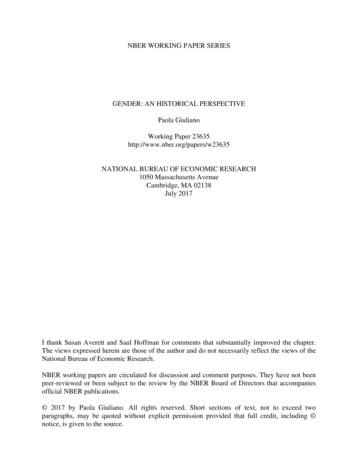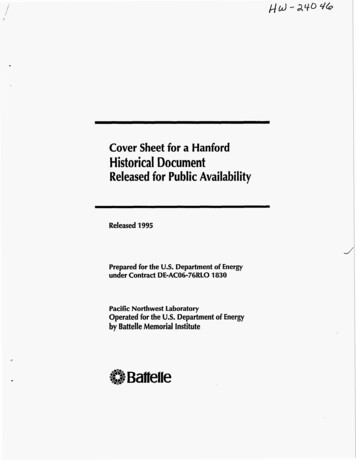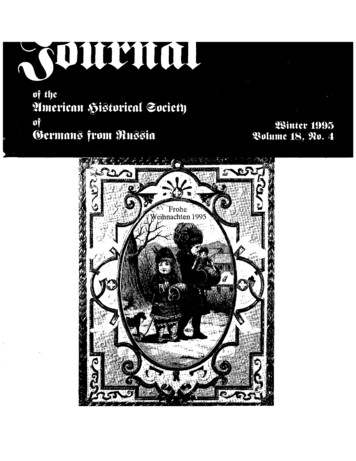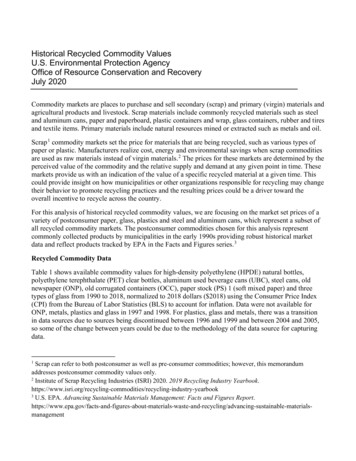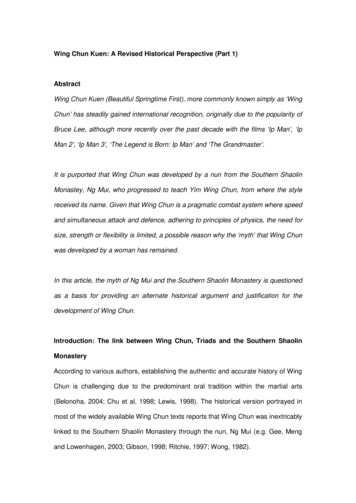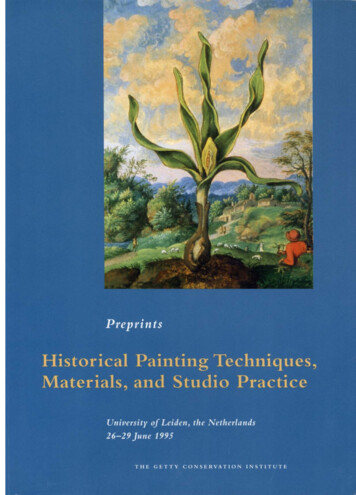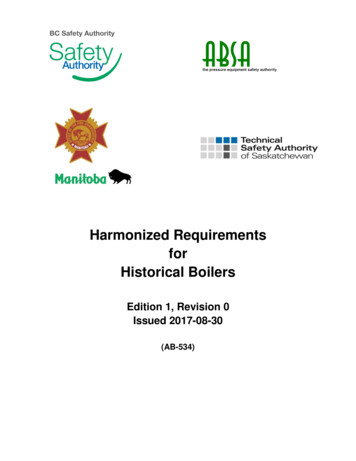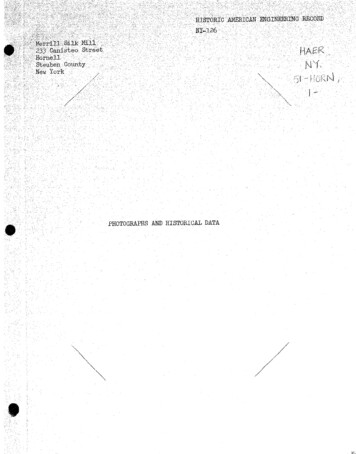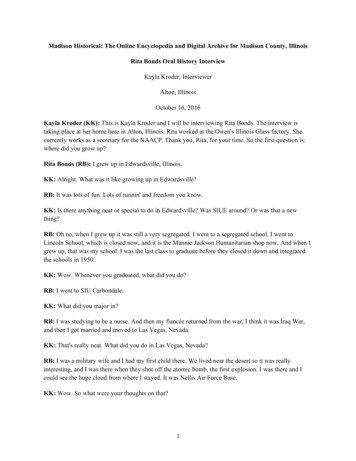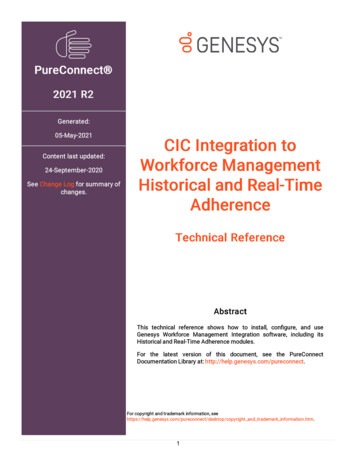
Transcription
Historical Overview of the National Woman’s PartyOrigins in the NAWSA Congressional CommitteeThe origins of the National Woman's Party (NWP) date from December 1912, whenAlice Paul (1885-1977) and Lucy Burns (1879-1966) were appointed to the National AmericanWoman Suffrage Association’s (NAWSA) languishing Congressional Committee. Paul andBurns were young, well-educated Americans who worked with Emmeline and ChristabelPankhurst in the militant wing of the British suffrage movement. Radicalized by theirexperiences in England–which included violent confrontations with authorities, jail sentences,hunger strikes, and force-feedings–they sought to inject a renewed militancy into the Americancampaign. They also endeavored to shift NAWSA’s attention away from winning voting rightsfor women at the state and local levels to securing an amendment to the U.S. Constitution toenfranchise women nationally.Their first activity on NAWSA’s behalf was to organize a massive national suffrageparade in Washington, D.C., in March 1913.This parade was modeled on the elaboratesuffrage pageants held in Britain and localmarches organized in New York by theWomen’s Political Union (WPU) and itsleader Harriot Stanton Blatch (1856-1940).Blatch, the daughter of Elizabeth CadyStanton (1815-1902), married an Englishmanand became active in the militant Britishsuffrage campaign. She supportedNAWSA’s appointment of Paul and Burns,who shared her enthusiasm for BritishContingent of women representing foreign countries in the March 3,inspired tactics.1913, suffrage parade in Washington, D.C. L & M Ottenheimer.About this imageThe March 3, 1913, parade coincidedwith President Woodrow Wilson’sinauguration and put the president-elect and Congress on notice that NAWSA would hold theDemocratic Party responsible if it failed to pass a women’s suffrage amendment. Bands, floats,and more than 8,000 marchers participated, representing nearly every state and mostoccupations.Despite assurances of police protection, crowds of men mobbed the parade route–some ofthem threatening or injuring the marching women. The police declined to intervene, and thepublic outcry was intense. Even NAWSA officials, leery of Paul’s affiliation with Britishsuffragettes, conceded afterwards that the parade and ensuing police debacle had “. . .done morefor suffrage, to establish firmly those who were wavering, and to bring to our ranks thousands ofothers who would never have taken any interest in it.”1 (For a fuller description of the parade, see“Marching for the Vote: Remembering the Woman Suffrage Parade of 1913.")Despite the publicity that such events generated, Anna Howard Shaw (1847-1919) andlater Carrie Chapman Catt (1859-1947), as presidents of NAWSA, remained skeptical. Theyfeared that militant tactics would endanger state victories, antagonize Congress, and make itdifficult to gain widespread support for ratifying women’s voting rights if a federal amendmentThe Library of Congress American MemoryWomen of Protest: Photographs from the Records of the National Woman’s Party
2were passed by Congress. They believed that British-influenced tactics and the strategy oftargeting the party in power would not work in the United States where a bipartisan coalitionusually was needed to achieve the necessary two-thirds majority vote in Congress and states’ratification.Establishment of the Congressional Union and Its Early TacticsIncreasingly at odds with NAWSA leadership and interested in raising funds andpursuing activities outside NAWSA’s scope, Paul and Burns founded the Congressional Unionfor Woman Suffrage (CU) in April 1913. The NAWSA Congressional Committee and the CUwere separate entities, but Paul chaired both, and the executive boards were identical. The CU,initially consisting of women in the District of Columbia who supported the CongressionalCommittee, established its own weekly journal, The Suffragist, in November 1913. One monthlater, immediately following NAWSA’s annual convention, Paul was told that she could retainher chairmanship of the Congressional Committee only if she resigned from the CU andabandoned the policy of holding all Democrats responsible for congressional inaction onsuffrage. Paul refused, as did Lucy Burns and the other committee members. NAWSA removedthem and selected a new Congressional Committee. Two months later, in February 1914,NAWSA and the CU went their separate ways when the NAWSA board voted againstreadmitting the CU as an auxiliary member.From 1914 to 1917, the CU, with its national headquarters in Washington and statebranches throughout the country, instilled in the flagging American suffrage campaign an energyand militancy reminiscent of the early radicalism ofStanton and Susan B. Anthony (1820-1906). CUmembers held street meetings, distributed pamphlets,organized elaborate parades and pageants, heckledcandidates, collected signatures on suffrage petitions,mounted billboards on public highways, and orchestratedcoast-to-coast automobile and train tours of suffragespeakers. The CU also arranged for deputations of womento meet with the president, encouraged western womenalready enfranchised to vote as a bloc in the 1914congressional and 1916 presidential elections, and kept anSuffrage envoys from San Francisco greeted in NewJersey on their way to Washington to present aextensive card index file on every member of Congress aspetition to Congress containing more than 500,000signatures. November-December 1915.an aid in its relentless lobbying effort. All of its tacticsAbout this imagewere designed to generate interest and publicity, attractnew supporters, and pressure public officials.Formation of the National Woman’s PartyIn early June 1916, the CU sponsored a convention in Chicago for women in the Westwho had achieved voting rights in their states. The National Woman’s Party (NWP)–also brieflyknown as the Woman’s Party of Western Voters or simply the Woman’s Party–emerged as aresult of this conference. CU member and Washington lobbyist Anne Martin (1875-1951) ofNevada became the NWP’s first chairman. The goal of the world’s “first women’s politicalparty” was to remain independent of the existing political parties and to campaign on a platformThe Library of Congress American MemoryWomen of Protest: Photographs of the Records of the National Woman’s Party
3consisting of one plank–immediate passage of the Susan B. Anthony federal suffrageamendment. The CU continued to exist in states where women did not have the vote; the NWPreplaced the CU in western states that had passed women’s suffrage. The two groups coexisteduntil March 1917 when the voting and non-voting wings reunited in a single organization underthe NWP name.From June to November 1916, both the NWP and CU concentrated on the upcomingelections. They picketed the national conventions, metwith presidential and congressional candidates, and sentorganizers into the enfranchised states to lobby for thefederal suffrage amendment and oppose all DemocraticParty candidates. In late October, suffrage speaker InezMilholland Boissevain (1886-1916) collapsed whilespeaking on stage in Los Angeles. She died on November25 and was widely regarded as the first martyr of theAmerican women’s suffrage movement. A memorialservice was held on Christmas Day in the U.S. Capitol,and resolutions were prepared for President Wilson’sNWP member puts up a billboard in Denver duringattention. When Wilson angrily dismissed the suffragists’the 1916 election campaigns.About this imagedemands, Paul decided, with Blatch’s urging, to escalatetheir agitation.Picketing, Arrests, and ImprisonmentOn January 10, 1917, the CU and NWP instituted the practiceof picketing the White House, the first political activists to do so. Everyday for the next two months, regardless of weather, women marched ina line from CU headquarters to the White House, where they took uptheir stations as “silent sentinels.” In order to keep the press interested,special days were scheduled for picketing by college women, wageearners, and representatives from various states, occupations, andprofessional affiliations. President Wilson initially tolerated the pickets,waving to them as his car pulled through the gates. However, when theUnited States entered World War I four months later, the politicalclimate changed, and criticism of the government became lessacceptable.“Silent sentinel” Alison T.Unlike other suffragists, including longtime pacifists whoHopkins at the White Housegates on New Jersey Day.stopped campaigning for the vote and devoted themselves to war work,January 30, 1917.the NWP neither publicly supported the war nor halted agitating forAbout this imagewomen’s voting rights.The NWP highlighted the government’s hypocrisy of supporting democracy abroad whiledenying its women citizens the right to vote at home. NWP criticism of the government wasviewed as unpatriotic by many and even seditious and subversive by some, especially thesoldiers and sailors who were among the most visible instigators of mob violence against thepickets. The party firmly defended the rights of free speech, free assembly, and dissent.NAWSA’s Catt publicly disassociated her organization from the NWP’s “unladylike” behaviorand the “unwelcome” publicity it generated, although NAWSA benefitted by appearing moreThe Library of Congress American MemoryWomen of Protest: Photographs of the Records of the National Woman’s Party
4moderate and approachable to politicians who were beginning to rethink their antisuffragepositions.On June 22, 1917, suffrage pickets began to bearrested on the technical charge of obstructing traffic. As thesummer progressed, more arrests followed and longer prisonsentences were handed down. The women were imprisoned–usually in unsanitary conditions, sometimes beaten (mostnotably during the November 15 “Night of Terror” atOccoquan Workhouse), and often brutally force-fed whenthey went on hunger strikes to protest being denied politicalprisoner status.Women of all classes risked their health, jobs, andSuffrage prisoner Lucy Branham, in prisoncostume, being filmed while addressing anreputations by continuing their protests. One historianopen-air meeting [detail]. 1919.estimated that approximately 2,000 women spent time on theAbout this imagepicket lines between 1917 and 1919, and that 500 womenwere arrested, of whom 168 were actually jailed2. The NWP made heroes of the suffrageprisoners, held ceremonies in their honor, and presented them with commemorative pins.Women went on publicity tours dressed in prison garb and talked about their experiences inprison in order to win public support for their cause.Congressional Passage of 19th Amendment and Ratification CampaignGovernment officials found it increasingly difficult to refuse the vote to women whowere contributing so much to the war effort. Antisuffragist arguments about women’s mental andphysical inferiority were difficult to sustain as women took overjobs vacated by men drafted into military service. In addition,the NWP’s militant tactics and the public support its membersgarnered from their imprisonment, combined with persistent,low-key lobbying, eventually forced President Wilson toendorse the 19th Amendment on January 9, 1918. The next day,it passed in the House of Representatives.Obstructionists from southern and eastern states delayedpassage in the Senate until June 1919, during which time NWPmembers continued to lobby and protest. They establishedAlice Paul unfurls the ratification flag frompicket lines in front of the U.S. Capitol and the Senate OfficeNWP headquarters after Tennesseebecomes the 36th state to ratify 19thBuilding in October 1918; started a watch fire campaign onAmendment. National Photo Co. AugustJanuary 1, 1919, in front of the White House to pressure18, 1920.About this imagePresident Wilson to lobby recalcitrant senators to pass thesuffrage amendment; burned Wilson’s words and image ineffigy; and sent suffrage prisoners on a cross-country speaking tour aboard a train named“Democracy Limited” in February and March 1919.On May 21, 1919, the U.S. House of Representatives again passed the Susan B. Anthonyfederal suffrage amendment, and on June 4, the U.S. Senate followed suit. The enactment of theamendment initiated a 14-month campaign for ratification by 36 states. During this time theNWP sent national organizers into key states to help local NWP members coordinate ratificationefforts. Finally, on August 18, 1920, Tennessee became the 36th state to ratify the 19thThe Library of Congress American MemoryWomen of Protest: Photographs of the Records of the National Woman’s Party
5Amendment. Antisuffragists tried to overturn the vote, but after six more days of legalmaneuvering, the Tennessee governor signed the certificate of ratification and mailed it toWashington on August 24. Two days later, on August 26, Secretary of State Bainbridge Colbysigned the 19th Amendment into law.Equal Rights Amendment and Post-Suffrage ActivitiesOnce suffrage was achieved, the NWP regrouped and focused its attention on passing afederal Equal Rights Amendment (ERA), drafted by Paul and first introduced in Congress inDecember 1923. The party withstood attacks from women’s groups who opposed the ERA as athreat to sex-based protective labor legislation and kept the issue alive for decades until therenewed ERA campaign in the 1970s.Throughout the 20th century, the NWP remained a leading advocate of women’s political,social, and economic equality. In the 1920s, the NWP drafted more than 600 pieces of legislationin support of equal rights for women on the state andlocal levels, including bills covering divorce and custodyrights, jury service, property rights, ability to enter intocontracts, and the reinstatement of one’s maiden nameafter marriage. It launched two major “Women ForCongress” campaigns in 1924 and 1926 and lobbied forthe appointment of women to high federal positions. Theparty also worked for feder
Party candidates. In late October, suffrage speaker Inez Milholland Boissevain (1886-1916) collapsed while speaking on stage in Los Angeles. She died on November 25 and was widely regarded as the first martyr of the American women’s suffrage movement. A memorial service was held on Christmas
